Explore Zanzibar - Tanzania Travel, Africa
Zanzibar, an enchanting archipelago in the Indian Ocean, lies about 40 kilometers off Tanzania’s eastern coast. Comprising several islands, with Unguja (commonly known as Zanzibar Island) and Pemba Island being the largest, Zanzibar is celebrated for its stunning beaches, rich cultural heritage, and historical significance. Just south of the equator, this tropical paradise enjoys a warm climate year-round, attracting visitors with its blend of African, Arab, and Indian influences. Whether exploring spice farms, snorkeling in crystal-clear waters, or savoring local dishes like biryani and Zanzibar pizza, travelers find Zanzibar a captivating destination.
Population: Estimate 30,000 people in 2024
Economy: Zanzibar's economy relies heavily on tourism, agriculture, and fishing. The island is known for its spice production, particularly cloves, and attracts visitors with its rich culture and beautiful beaches. Tourism is the largest contributor, driving growth and development.
Landmarks: Famous for the Stone Town, Prison Island ( or Changuu Island), and the Jozani Forest (an important part of the Jozani Chwaka Bay National Park).
Tanzania
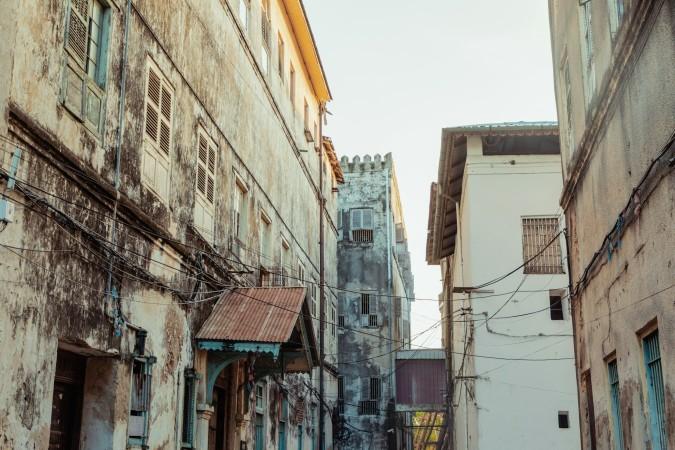
Overview of Zanzibar
History & Cultural Influence
Zanzibar's history is marked by a rich tapestry of cultural influences, primarily shaped by its strategic location as a major trade hub in the Indian Ocean. Originally settled by Bantu-speaking peoples, the islands saw significant Arab, Persian, Indian, and European interactions beginning in the 7th century, leading to a unique blend of cultures. The Omani Sultanate took control in the late 17th century, establishing Zanzibar as a center for the spice trade and the slave trade, which profoundly impacted its social fabric and economy. Today, Zanzibar is celebrated for its vibrant culture, characterized by the Swahili language, a fusion of local dialects and Arabic, and a culinary scene rich in spices.
Interaction with The Locals
When you visit Zanzibar, you can expect warm and friendly interactions with the locals, who are renowned for their hospitality and welcoming nature. The population is predominantly Swahili, with a blend of Arab, Persian, Indian, and African influences, reflecting the island's rich history as a trade hub. Locals generally have a positive attitude towards tourists, appreciating the economic benefits that tourism brings, though there are ongoing discussions about ensuring these benefits are shared equitably within the community.
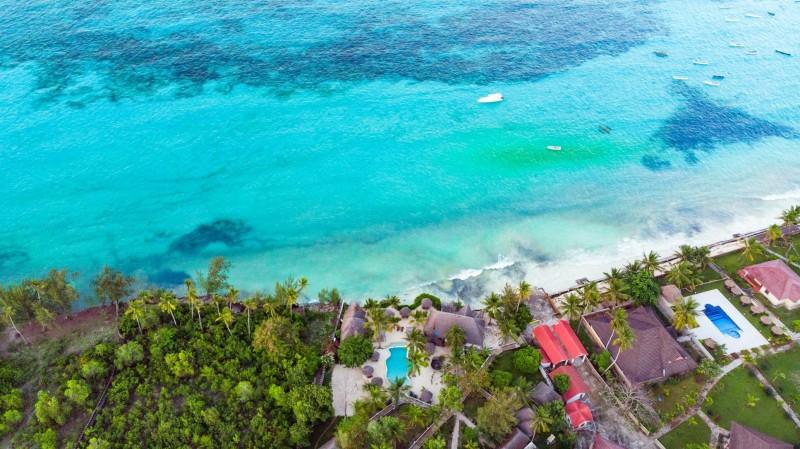
Nungwi Beach - © Moses Londo
Top Attractions in Zanzibar
Zanzibar offers a rich blend of history and natural beauty, with Stone Town standing out as a UNESCO World Heritage Site known for its narrow alleys and coral stone buildings. These attractions, along with the island's vibrant culture and stunning landscapes, make Zanzibar a must-visit destination.
- Stone Town: Stone Town is the historical heart of Zanzibar, renowned for its narrow alleys, coral stone buildings, and vibrant cultural heritage. As a UNESCO World Heritage Site, it boasts iconic landmarks like the Old Fort and the House of Wonders.
- Prison Island (Changuu Island): Once used as a prison for rebellious slaves, Prison Island is now a popular destination where you can see giant tortoises and enjoy snorkeling in the island's clear, inviting waters.
- Jozani Forest (Jozani Chwaka Bay National Park): Home to the endangered Zanzibar red colobus monkey, Jozani Forest is a lush national park featuring mangrove forests and diverse wildlife, making it perfect for nature walks and wildlife viewing.
- Nungwi Beach: Nungwi Beach is famous for its pristine white sands and vibrant nightlife. It’s an ideal spot for swimming, snorkeling, and taking in the breathtaking sunsets that the northern coast of Zanzibar is known for.
- Kizimkazi: Kizimkazi is well-known for its dolphin tours, offering you the chance to swim with dolphins in their natural habitat. The area also boasts beautiful beaches and significant cultural heritage sites.
- Freddie Mercury Museum: Located in the childhood home of the legendary Queen frontman, the Freddie Mercury Museum is a must-visit for fans, showcasing memorabilia and photographs that celebrate his extraordinary life and career.
- Nakupenda Beach: Nakupenda Beach is a stunning sandbank with crystal-clear waters and soft white sands. It’s an idyllic spot for sunbathing, swimming, and enjoying a peaceful day by the sea.
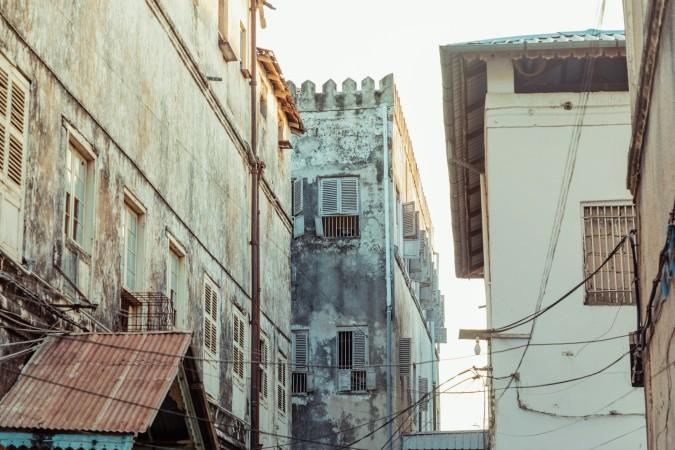
Buildings in Zanzibar Stone Town - © Alferio Njau
Must-Try Dishes in Zanzibar
When visiting Zanzibar, be sure to try the island’s local specialty. Don’t miss the fragrant Zanzibari biryani among other must-try local dishes, a showcase of Zanzibar’s rich culinary heritage.
- Zanzibar Pizza: Zanzibar pizza is a must-try street food made from a thin, crispy dough. It's stuffed with an assortment of ingredients like minced meat, vegetables, eggs, and cheese, then folded and grilled to perfection.
- Biryani: Zanzibari biryani is a fragrant and flavorful rice dish, often cooked with tender chicken, goat, or seafood, and spiced with a rich blend of cardamom, cloves, and cinnamon. Garnished with fried onions and boiled eggs, this dish is a feast for the senses.
- Uji: Uji is a simple yet comforting porridge made from millet or corn flour, commonly enjoyed for breakfast across Zanzibar. It can be sweetened with sugar, honey, or spiced with a touch of ginger or cinnamon. This dish is a nod to the island’s agricultural traditions, highlighting the importance of grains in the local diet.
- Seafood Curry: Freshly caught fish, prawns, or octopus are simmered in a rich, creamy coconut milk sauce, spiced with turmeric, ginger, and garlic. This dish perfectly encapsulates the essence of Zanzibari cuisine—simple, fresh ingredients, elevated by the island’s world-renowned spices.
- Chapati: Chapati, an unleavened flatbread, is a staple in Zanzibari meals, often accompanying curries, stews, or even served alone with a bit of honey or sugar for a snack. This versatile bread reflects the Indian influence on Zanzibari cuisine and plays an essential role in many households.

Zanzibar Pizza - © Plochman's Mustard
Festivals & Local Celebrations
Sauti za Busara Music Festival
Held in Stone Town during February, the Sauti za Busara Music Festival is a lively celebration of African music, featuring over 400 artists performing genres ranging from traditional taarab to contemporary hip-hop. You can expect vibrant street parades, live performances, and a festive atmosphere that highlights the richness of African culture.
Zanzibar International Film Festival (ZIFF)
As one of East Africa's largest cultural events, ZIFF offers a platform for filmmakers from Africa and beyond to showcase their talents. The festival includes film screenings, workshops, and performances, along with outdoor cinema experiences and live music, making it a must-visit for film enthusiasts and culture lovers alike.
Mwaka Kogwa Festival
Celebrated in Makunduchi during July, the Mwaka Kogwa Festival marks the Shirazi New Year with unique traditions and rituals. Highlights include mock fights with banana tree branches and the lighting of bonfires, symbolizing the clearing of past grievances and welcoming the new year with joy and community spirit.
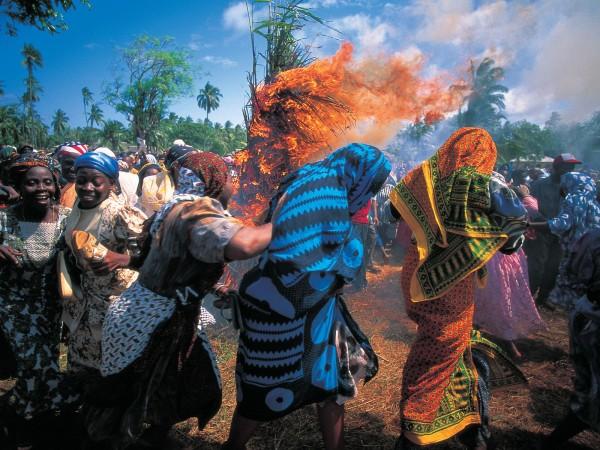
Mwaka Kogwa Festival - © Zanzibar Commission for Tourism
What to Do in Zanzibar
- Snorkeling and Diving: The crystal-clear waters around Mnemba Atoll and Chumbe Island are perfect for snorkeling and diving. You’ll witness vibrant coral reefs and a variety of marine life, including dolphins, turtles, and colorful fish. Whether you're a seasoned diver or a beginner, there are plenty of dive centers offering equipment and guided tours that will introduce you to some of the most beautiful underwater ecosystems in the Indian Ocean.
- Spice Tours: As the "Spice Island," Zanzibar is famous for its spice farms. A spice tour is a must-do activity where you can walk through plantations, smell fresh cloves, cinnamon, and nutmeg, and learn about the island's spice trade history. Local tour guides often share insights into traditional medicinal uses of these spices, making it both an educational and sensory experience.
- Dhow Cruises: A sunset dhow cruise offers a more peaceful experience. These traditional wooden boats cruise around Zanzibar's shores, providing stunning views of the sunset.
- Kitesurfing: For those seeking more adventure, Zanzibar’s southeastern coast, particularly around Paje, is a hotspot for kitesurfing. The consistent winds and flat waters make it ideal for both beginners and experienced kite surfers.
Shopping in Zanzibar
- Stone Town Markets: The Darajani Market is particularly famous for spices, textiles, and fresh produce, and a sensory overload of smells, sights, and sounds. It’s the perfect place to buy authentic Zanzibar spices to take home, along with handcrafted items such as carved wooden boxes, Maasai jewelry, and colorful kangas (traditional fabrics).
- Handcraft Stores: Zanzibar is home to talented artisans who create beautiful handmade products. Intricately carved wooden furniture, beaded jewelry, and woven baskets are among the most sought-after items. Many shops in Stone Town sell these crafts, which make for excellent souvenirs or gifts.
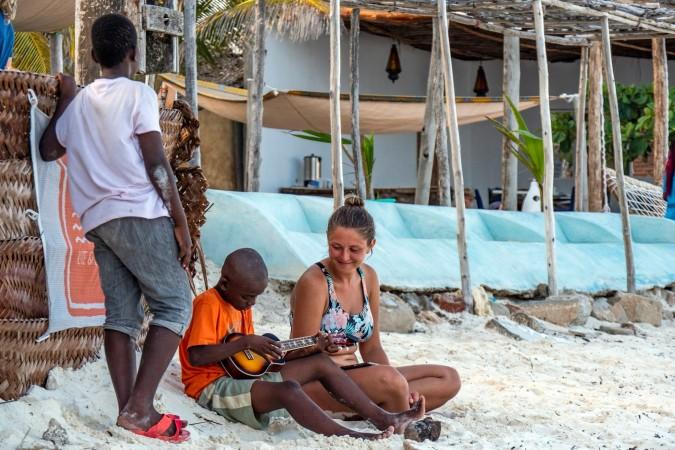
Relax with the locals on Zanzibar beach - © Majkl Velner
Weather in Zanzibar: Best Time to Visit
Average Temperatures
Throughout the year, Arusha’s temperatures vary:
- January to March: Expect daytime highs between 27°C and 29°C (81°F to 84°F), with cooler nights around 10°C to 11°C (50°F to 52°F).
- April to May: As temperatures begin to cool, highs range from 22°C to 25°C (72°F to 77°F), with nighttime lows of 11°C to 13°C (52°F to 55°F). April is the wettest month.
- June to August: This is the coolest period, with average highs of 20°C to 22°C (68°F to 72°F) and lows dipping to 8°C to 10°C (46°F to 50°F), with July typically being the coldest month.
- September to December: Temperatures rise again, with highs reaching 26°C to 29°C (79°F to 84°F) and lows from 10°C to 13°C (50°F to 55°F).
Best Time to Travel
The ideal time to visit Arusha is during the dry seasons, particularly from June to September and January to February. These months offer pleasant weather, perfect for outdoor activities like safaris and hiking. If you’re traveling during June to August, be prepared for cooler evenings and early mornings.
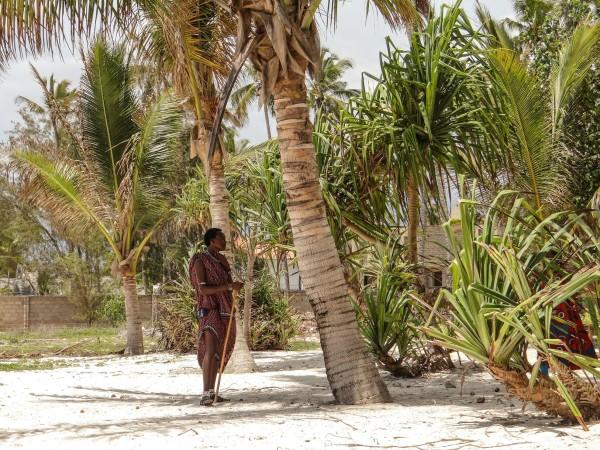
A Masai in traditional Masai dress on Zazibar beach - © Lidia Stawinska
Essential Travel Information
Getting Around Zanzibar
- Taxis and Shuttles: You can pre-booked online for convenience, ensuring a driver meets you upon arrival with a sign displaying your name. Services typically include flight monitoring and up to 120 minutes of free waiting time for delays.
- Dala-Dalas: These are shared minibuses that operate on set routes throughout the city and to nearby areas. They are a cost-effective way to travel but can be crowded and may not adhere to strict schedules.
- Buses: Larger buses connect Zanzibar with other major cities and tourist destinations. They are generally more comfortable than dala-dalas but may require advance booking during peak travel seasons.
- Taxis: Metered taxis are available throughout Zanzibar, but it's advisable to agree on a fare before starting your journey, as many taxis do not use meters.
ATM & Banking Services
Zanzibar has a limited number of ATMs, mostly concentrated in Stone Town and a few tourist spots like Nungwi and Paje. It's important to note that ATMs can sometimes run out of cash, so it's wise to withdraw enough when you find one that’s stocked. The maximum withdrawal limit is typically 400,000 Tanzanian Shillings (around $130), and fees may apply, so check with your bank about international usage before you travel. Currency exchange is primarily available at banks and designated bureaus, with 24/7 services at the airport for added convenience.
Where to Stay in Zanzibar
- Luxury Resorts: Zanzibar is home to several luxury resorts that offer stunning beachfront locations, world-class amenities, and personalized services. These resorts typically feature private villas, infinity pools, fine dining restaurants, and wellness spas. Perfect for couples or honeymooners, these resorts often offer activities like private boat trips, guided tours, and exclusive beach access, ensuring a relaxing and indulgent stay.
- Mid-Range Hotels: If you're looking for a balance between comfort and affordability, Zanzibar has a variety of mid-range hotels. These establishments offer modern amenities like air conditioning, swimming pools, and on-site restaurants while still keeping you close to the island's top attractions.
- Beachfront Villas: If you prefer more privacy, Zanzibar’s beachfront villas provide a tranquil escape with all the comforts of home. These standalone accommodations are often equipped with private pools, kitchens, and spacious living areas, making them ideal for families or groups. Located directly on the beach, these villas offer breathtaking ocean views and easy access to the water.
Des articles pour vous

Voyage à Kampong Cham - Cambodge, Asie
Kampong Cham est une charmante ville riveraine située le long du fleuve Mékong. Connue pour son importance historique et ses attractions culturelles, Kampong Cham offre un mélange d'architecture coloniale, de temples anciens et de paysages pittoresques. Kampong Cham est reliée au district voisin de Tbong Khmum par le pont Kizuna, le premier pont au Cambodge à traverser le fleuve Mékong, en faisant un carrefour de transport crucial pour la région.
Population : Estimation de 80 000 habitants (en 2024)
Économie : Bien que n'étant pas encore une destination touristique majeure, Kampong Cham propose des sites culturels et historiques, tels que le temple Wat Nokor et le pont en bambou de Koh Pen, ainsi que des attractions naturelles comme des forêts et des chutes d'eau. Le gouvernement se concentre sur le développement du tourisme pour améliorer l'économie locale.
Points d'intérêt : Wat Nokor Bachey, Phnom Han Chey, Phnom Pros et Phnom Srey, pont en bambou de Koh Pen, Wat Joy T'maw, Preah Theat Teuk Chha, piste d'atterrissage abandonnée de l'US.

Explorez Nha Trang - Voyage au centre du Vietnam, Asie
Nichée le long de la magnifique côte du Vietnam, Nha Trang se distingue comme une destination de premier choix pour les voyageurs. Cette ville côtière, réputée pour ses superbes plages et sa vie marine foisonnante, s'adresse à tous. Nha Trang vous accueille à bras ouverts, que vous recherchiez des aventures, de la culture ou de la détente au bord de la mer. Ce guide vous fera découvrir les points forts de cet endroit magnifique, facilitant ainsi la planification de votre voyage de manière fluide et excitante.
Population : Environ 423 000 habitants en 2019.
Économie : L'un des principaux centres touristiques du Vietnam et la plus grande économie de la province de Khanh Hoa.
Sites emblématiques : Célèbre pour les tours Cham de Po Nagar, la cathédrale de Nha Trang et l'île Hon Mun.

Voyage à Sihanoukville - Cambodge, Asie
Sihanoukville, une ville côtière du sud-ouest du Cambodge, est la capitale de la province de Preah Sihanouk. Située sur une péninsule le long du golfe de Thaïlande, la ville est bien reliée à Phnom Penh par des autoroutes principales et dispose d'un aéroport international.
La ville abrite le seul port en eau profonde du Cambodge, jouant un rôle crucial dans la logistique et le commerce du pays. Les plages magnifiques de Sihanoukville, telles qu'Ochheuteal et Serendipity, attirent aussi bien les touristes nationaux qu'internationaux. Le développement économique a prospéré ces dernières années, en particulier grâce à la création de la Zone économique spéciale de Sihanoukville (SSEZ) et aux investissements chinois dans les casinos, l'immobilier et les stations balnéaires. La ville offre également des attractions naturelles telles que le parc national de Ream et plusieurs îles voisines, en faisant une destination variée pour les voyageurs d'affaires et de loisirs.
Population : La population de Sihanoukville était d'environ 160 000 habitants en 2024.
Économie : Sihanoukville, une ville côtière en pleine croissance au Cambodge, se distingue par son mélange dynamique de développement économique et de tourisme. La Zone économique spéciale de Sihanoukville (SSEZ) est devenue un pôle industriel majeur, abritant plus de 180 entreprises et créant des milliers d'emplois. Avec le seul port en eau profonde du Cambodge, la ville joue un rôle clé dans le commerce et la logistique du pays. Bien qu'elle se soit transformée d'une petite ville balnéaire tranquille en un centre urbain animé, Sihanoukville reste célèbre pour ses plages immaculées, attirant des touristes tout au long de l'année. Les investissements chinois importants ont alimenté la croissance des hôtels, des casinos et de l'immobilier, faisant de la ville un centre d'opportunités économiques et d'hospitalité.
Monuments : Plage d'Otres, Plage d'Ochheuteal, Plage de l'Indépendance, Parc national de Ream, Chute d'eau de Kbal Chhay, Monument des Lions d'Or, Wat Leu.

Explorez Kharkhorin - Voyage en Mongolie, Asie
Bienvenue à Kharkhorin, un trésor historique niché au cœur de la Mongolie. Ancienne capitale vibrante de l'Empire Mongol sous le légendaire Gengis Khan, Kharkhorin se dresse comme un témoignage de la riche culture et de l'histoire de la Mongolie. Cette ville antique possède une combinaison unique d'importance historique et de paysages époustouflants, en faisant une destination incontournable pour un voyage de rêve en Mongolie. En mettant le pied à Kharkhorin, vous ferez un saut dans le temps, à une époque de grands palais, de routes commerciales prospères et d'échanges culturels sans pareils. Que vous soyez intrigué par les ruines anciennes, désireux d'explorer les traditions locales ou simplement en quête d'une immersion dans la beauté naturelle de la Mongolie, Kharkhorin a quelque chose à offrir à chacun.
Population : Environ 1 000 habitants en 2020.
Économie : L'une des attractions touristiques les plus importantes de la Mongolie et l'ancienne capitale de l'Empire Mongol.
Monuments : Célèbre pour les Ruines de Kharkhorin, le Monastère d'Erdene Zuu, et la Vallée d'Orkhon, un site du patrimoine mondial de l'UNESCO.

Explore Luang Prabang - Laos Travel, Asia
Luang Prabang, nestled in northern Laos at the meeting point of the Mekong river and Nam Khan river, is a city celebrated for its rich cultural heritage and stunning natural beauty. Recognized as a UNESCO World Heritage Site in 1995, it boasts a unique blend of traditional Lao and French architecture that has been carefully preserved. Whether you're wandering through its ancient temples, admiring the local architecture, or soaking in the natural beauty of waterfalls and rivers, Luang Prabang offers something for everyone.
Population: Approximately 470,000 in 2020.
Economy: Luang Prabang's economy thrives on tourism, with its UNESCO status drawing visitors to its temples, natural wonders, and cultural experiences. Local crafts, hospitality, and small businesses also play vital roles, supporting the town's sustainable growth. Local crafts, hospitality, and small businesses also play vital roles, supporting the town's sustainable growth.
Landmarks: Famous for the Wat Xieng Thong, Royal Palace Museum (also known as Haw Kham), and Mount Phousi (Phou Si Hill).Luang Prabang, nestled in northern Laos at the meeting point of the Mekong river and Nam Khan river, is a city celebrated for its rich cultural heritage and stunning natural beauty. Recognized as a UNESCO World Heritage Site in 1995, it boasts a unique blend of traditional Lao and French architecture that has been carefully preserved. Whether you're wandering through its ancient temples, admiring the local architecture, or soaking in the natural beauty of waterfalls and rivers, Luang Prabang offers something for everyone.
Population: Approximately 470,000 in 2020.
Economy: Luang Prabang's economy thrives on tourism, with its UNESCO status drawing visitors to its temples, natural wonders, and cultural experiences. Local crafts, hospitality, and small businesses also play vital roles, supporting the town's sustainable growth. Local crafts, hospitality, and small businesses also play vital roles, supporting the town's sustainable growth.
Landmarks: Famous for the Wat Xieng Thong, Royal Palace Museum (also known as Haw Kham), and Mount Phousi (Phou Si Hill).

Explore Vientiane - Laos Travel, Asia
Vientiane, the capital of Laos, offers a unique travel experience for those looking to explore a peaceful Southeast Asian city with a deep connection to its cultural roots. Unlike other bustling capitals, Vientiane boasts a serene and laid-back atmosphere, making it a perfect destination for travelers wanting to escape the chaos of more crowded cities. This charming city sits along the Mekong River, offering scenic views, rich history, and a vibrant yet tranquil way of life. As a gateway to exploring Laos, this capital invites you to slow down, immerse in its heritage, and enjoy the local flavors.
Population: Approximately 840,000 in 2023.
Economy: Vientiane's economy is growing steadily, driven by government services, trade, and tourism. Key sectors include agriculture, manufacturing, and construction. The city's strategic location along the Mekong River supports trade with neighboring Thailand and Vietnam.
Landmarks: Famous for the Pha That Luang, Patuxai, and the Buddha Park (or Wat Xieng Khuan).
